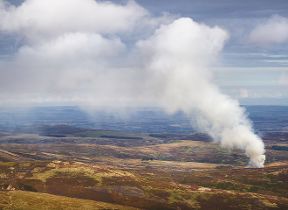The 11th NAME User Workshop
The 11th NAME User Workshop took place from 25th to 26th June, 2025.
The Met Office welcomed nearly 70 participants to a hybrid workshop to discuss recent developments and applications of the NAME atmospheric dispersion model.
The workshop was organised by members of the Atmospheric Dispersion and Air Quality group and brought together new and experienced users and model developers of the Met Office's atmospheric dispersion model NAME. The event provides a platform for sharing research and other model-related information, networking and strengthening links. This year the workshop was mainly held in-person to facilitate networking, but with online access to the oral sessions for those unable to travel. Participants attended from academia, government organisations, research institutions and commercial companies.
The NAME model and user community
The Numerical Atmospheric-Dispersion Modelling Environment (NAME) is a Lagrangian-Eulerian model developed by the Met Office to simulate the dispersion of a wide range of airborne pollutants from dispersion events such as nuclear accidents, volcanic eruptions, chemical accidents, smoke plumes from fires, and airborne animal and plant disease spread. In recent years, the NAME user community has seen continuous growth and the first user workshop was established in 2014.
Scientific content of the workshop
During the 2025 workshop, details were presented of collaborative projects and the use of NAME across many applications, organisations and countries. Interdisciplinary sessions covered the latest technical and scientific developments in NAME, inversion techniques and applications of the model to air quality, biological, chemical, radiological and volcanic dispersion.
Key topics presented at the workshop
We welcomed attendees from across the UK and around the world to present their work with a talk or poster and to explore the wide-ranging applications of NAME. From volcanic ash dispersion and air quality to radiological and biological releases and emergency response, the presentations highlighted just how vital NAME is across science and society. We also welcomed Bill Little, a Met Office senior developer from the Analysis and Visualisation of Data (AVD) team, to the workshop, who gave an excellent guest talk and demonstration of GeoVista for Next-Generation Interactive Visualisation of NAME Data.
Our Tech Bars brought NAME to life by showcasing real-world applications including tracing the source of a hazardous gas as well as demonstrating its operational use in emergency response. Participants were also invited to take part in a research study that explored how decision-makers interpret maps. Open discussions explored how we can adapt NAME for future climate scenarios and bring AI/ML techniques into our modelling workflows. To end the workshop, we had a behind-the-scenes tour of the Met Office media centre, where some attendees got to try their hand at presenting a weather forecast!
The next NAME User Workshop is expected to be held summer 2026.





